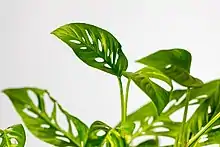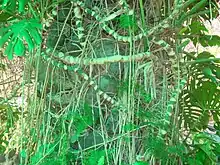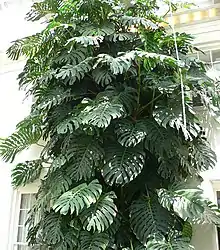| Monstera | |
|---|---|
 | |
| Monstera deliciosa | |
| Scientific classification | |
| Kingdom: | Plantae |
| Clade: | Tracheophytes |
| Clade: | Angiosperms |
| Clade: | Monocots |
| Order: | Alismatales |
| Family: | Araceae |
| Subfamily: | Monsteroideae |
| Tribe: | Monstereae |
| Genus: | Monstera Adans.[1] |
| Synonyms[2] | |
| |
Monstera is a genus of 59 species of flowering plants in the arum family, Araceae, native to tropical regions of the Americas.[2]
Etymology
The genus is named from the Latin word for "monstrous" or "abnormal", and refers to the unusual leaves with natural holes that members of the genus have.[3]
Description
Growth pattern
They are herbs or evergreen vines, growing to heights of 20 metres (66 ft) in trees, climbing by means of aerial roots which act as hooks over branches; these roots will also grow into the soil to help support the plant. Since the plant roots both into the soil and over trees, it is considered a hemiepiphyte.[4]
Leaves
The leaves are alternate, leathery, dark green, very large, from 25–90 centimetres (9.8–35.4 in) long (up to 300 centimetres (120 in) long in M. gigas) and 15–75 centimetres (5.9–29.5 in) broad, often with holes in the leaf blade. The fenestrated leaves allow for the leaves to spread over greater area to increase sunlight exposure, and to allow light to reach other leaves below, by using less energy to produce and maintain the leaves.[5]
Inflorescence
The flowers are borne on a specialized inflorescence called a spadix, 5–95 centimetres (2.0–37.4 in) long; the fruit is a cluster of berries, with significant variation in color, edible in some species.

Uses


They are commonly grown indoors as houseplants. The best-known representative of the genus, Monstera deliciosa, is also cultivated for its edible fruit which tastes like a combination of peach and pineapple.
Species
As of November 2022 Plants of the World Online recognizes 70 accepted taxa (of 64 species and 6 infraspecific names):[2][6]
- Monstera acacoyaguensis Matuda
- Monstera acuminata K.Koch – Shingle plant
- Monstera adansonii Schott
- Monstera adansonii subsp. adansonii (Schott) Mayo & I.M.Andrade
- Monstera adansonii subsp. blanchetii (Schott) Mayo & I.M.Andrade
- Monstera adansonii subsp. klotzschiana (Schott) Mayo & I.M.Andrade
- Monstera adansonii subsp. laniata (Schott) Mayo & I.M.Andrade
- Monstera alcirana Croat, M.Cedeño, Zuluaga & O.Ortiz
- Monstera alfaroi Croat & M.Cedeño
- Monstera amargalensis Croat & M.M.Mora
- Monstera anomala Zuluaga & Croat
- Monstera aureopinnata Croat
- Monstera barrieri Croat, Moonen & Poncy
- Monstera bocatorensis Croat & M.Cedeño
- Monstera boliviana Rusby
- Monstera buseyi Croat & Grayum
- Monstera cenepensis Croat
- Monstera costaricensis (Engl. & K.Krause) Croat & Grayum
- Monstera croatii M.Cedeño & A.Hay
- Monstera deliciosa Liebm. – Ceriman, Swiss-cheese plant
- Monstera dissecta (Schott) Croat & Grayum
- Monstera donosoensis Croat, M.Cedeño & O.Ortiz
- Monstera dubia (Kunth) Engl. & K.Krause
- Monstera egregia Schott
- Monstera epipremnoides Engl.
- Monstera filamentosa Croat & Grayum
- Monstera florescanoana Croat, T.Krömer & Acebey
- Monstera gambensis M.Cedeño & M.A.Blanco
- Monstera gentryi Croat, M.Cedeño & O.Ortiz
- Monstera gigas Croat, Zuluaga, M.Cedeño & O.Ortiz
- Monstera glaucescens Croat & Grayum
- Monstera gracilis Engl.
- Monstera guzmanjacobiae Diaz Jim., M.Cedeño, Zuluaga & Aguilar-Rodr.
- Monstera integrifolia Zuluaga & Croat
- Monstera juliusii M.Cedeño & Croat
- Monstera kessleri Croat
- Monstera kikiae Zuluaga & M.Cedeño
- Monstera kessleri Croat
- Monstera lechleriana Schott
- Monstera lentii Croat & Grayum
- Monstera limitaris M.Cedeño
- Monstera luteynii Madison
- Monstera maderaverde Grayum & Karney
- Monstera membranacea Madison
- Monstera minima Madison
- Monstera mittermeieri M.Cedeño
- Monstera molinae Croat & Grayum
- Monstera momoi M.Cedeño
- Monstera monteverdensis M.Cedeño & Croat
- Monstera obliqua Miq.
- Monstera oreophila Madison
- Monstera pinnatipartita Schott
- Monstera pittieri Engl.
- Monstera planadensis Croat
- Monstera praetermissa E.G.Gonç. & Temponi
- Monstera punctulata (Schott) Schott ex Engl.
- Monstera siltepecana Matuda
- Monstera spruceana (Schott) Engl.
- Monstera standleyana G.S.Bunting
- Monstera subpinnata (Schott) Engl.
- Monstera tablasensis M.Cedeño
- Monstera tacanaensis Matuda
- Monstera tarrazuensis Croat & M.Cedeño
- Monstera tenuis K.Koch
- Monstera titanum Croat, M. Cedeño & O.Ortiz
- Monstera tuberculata Lundell
- Monstera tuberculata var. brevinoda (Standl. & L.O.Williams) Madison
- Monstera tuberculata var. tuberculata
- Monstera vasquezii Croat
- Monstera wilsoniensis M.Cedeño & Grayum
- Monstera xanthospatha Madison

Previously included:
- Monstera alticola Croat
- Monstera bocatorana Croat & Grayum
- Monstera coloradensis Croat
- Monstera fortunense Croat
- Monstera gigantea (Roxb.) Schott - Epipremnum giganteum (Roxb.) Schott
- Monstera jefense Croat
- Monstera pirrense Croat
Commonly misidentified as Monstera:
References
- ↑ "Monstera". Germplasm Resources Information Network. Agricultural Research Service, United States Department of Agriculture. Retrieved 3 December 2022.
- 1 2 3 "Monstera". Plants of the World Online. Royal Botanic Gardens, Kew. Retrieved 5 December 2022.
- ↑ Quattrocchi, Umberto (2000). CRC World Dictionary of Plant Names. Vol. 3 M-Q. CRC Press. p. 1723. ISBN 978-0-8493-2677-6.
- ↑ Eskov, A. K.; Zhukovskaya, N. V.; Bystrova, E. I.; Orlova, Yu. V.; Antipina, V. A.; Ivanov, V. B. (2016). "Growth of aerial roots with an extensive elongation zone by the example of a hemiepiphyte Monstera deliciosa". Russian Journal of Plant Physiology. 63 (6): 822–834. doi:10.1134/S1021443716060042. S2CID 11839082.
- ↑ Choi, Charles (2013-01-22). "ScienceShot: Why Are There Holes in the Swiss Cheese Plant?". Science | AAAS. Retrieved 2021-05-03.
- ↑ "GRIN Species Records of Monstera". Germplasm Resources Information Network. USDA. Archived from the original on October 19, 2012. Retrieved January 1, 2013.